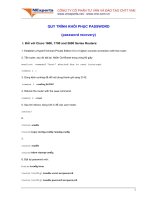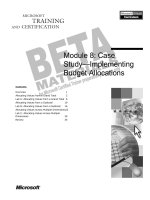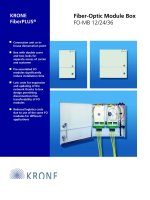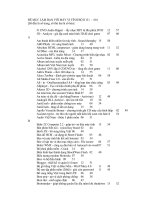Tài liệu Indoor Wireless Coverage Multilevel Corporate Technology Campus pptx
Bạn đang xem bản rút gọn của tài liệu. Xem và tải ngay bản đầy đủ của tài liệu tại đây (1.26 MB, 4 trang )
CASE STUDY
Indoor Wireless Coverage
Multilevel Corporate Technology Campus
Customer
A global telecommunications manufacturer recently moved into a new
500,000-square-foot world headquarters facility housing just under
5,000 employees. Two major wireless service providers supplied service
to a majority of the company’s mobile phone users. Nearly 60 percent of
those phone users at the new campus complained they could not make
or receive wireless calls within the facility.
The Problem
Mobile phones have become a primary means of communication in
many people’s lives, including those working within this company’s
customer service department. But as employees moved into the
new state-of-the-art facility, it became apparent that this vital line of
communication was in jeopardy.
The new facility is a three-building campus, constructed of brick,
concrete, and steel, with extensive use of low-e, architectural and solar
glass. Each three-story building has one or two levels below ground. The
buildings are connected by skyways and an 8-foot concrete basement
tunnel. The construction materials used throughout the facility make
transmitting and receiving RF signals extremely difficult. Inside, the
design of the facility created many more challenges due to its open
architecture and frequent use of 3-foot-thick concrete pillars, hampering
quality wireless coverage throughout the facility.
CASE STUDY
The company has placed a premium on customer service, and a critical benchmark to that is the
customer’s ability to reach a knowledgeable customer service person on the first call. For this reason,
many customer service representatives forward their desk calls to their mobile phone when away from
their desk. But if they couldn’t receive mobile calls within the facility, they wouldn’t be able to maintain
their excellent level of customer service.
The ADC Solution
The alternatives for providing RF coverage within the new facility were less than ideal. The company
studied many possible options to solve the problem, but most were either too expensive or sacrificed
quality for cost savings. One option was to place base transceiver stations (BTS) within the facility.
Base stations are typically only used for in-building applications when the call capacity required within
the building justifies offloading traffic from the macro system. The potential revenue from the in-
building coverage would need to be extremely high to justify the cost of a BTS. Another option was to
radiate the signal through “leaky coaxial” cable. While this is a low-cost alternative, it requires added
amplification to maintain signal strength, resulting in degradation of the signal-to-noise ratio. Still
another consideration was to install a wireless office system in only the building that customer service
representatives worked, but this would restrict their mobility and hamper them from receiving customers’
calls while in other parts of the campus.
The client’s Network Technology Services department chose ADC’s Digivance
®
Indoor Coverage Solution
for its flexibility and scalability, and because it’s the only all-digital distributed antenna system (DAS)
that transports RF signals digitally within buildings. ADC’s systems engineers performed the initial
design, conducted a walk-through to measure signal levels throughout the building, and determined
the necessary equipment. ADC’s Systems Integration engineers then routed the cables and installed the
equipment.
Because 85 percent of the mobile service used by this company’s employees is primarily provided through
two different service providers, the system was designed to accommodate both of the major service
providers. RF signals are relayed to the building via airlink from two directional antennas placed on
the roof. Each antenna points toward the nearest macro cell site for the specified service provider. The
Digivance ICS system then interfaces with the cell sites through Digivance Remote Interface Units (RIU),
which provide necessary signal level adjustments on both the uplink and downlink paths.
By using ADC’s patented technology, the Digivance ICS digitizes the entire designated RF band and
digitally transports it over fiber, a technology through which signals are replicated at full dynamic
range regardless of the fiber length or number of splits. Digital RF transport introduces no loss due to
attenuation and no degradation of the quality of the signal. Because the entire bandwidth is digitized,
transportation of the signal is transparent to modulation technology, and the signal is reconstructed at
full bandwidth. In addition, balancing the system is not required, saving valuable installation and setup
time. ADC’s patented digital RF transport technology also maintains the signal’s high dynamic range,
which increases the capability for data throughput and enables the system to handle the high data rates
of broadband service.
The Digivance ICS system is modular, consisting of a digital host unit (DHU), optional digital expansion
unit (DEU), and digital remote units (DRU). The modules are connected by pairs of multimode fiber. The
flexible architecture allows DRUs to be connected either directly to the DHU or indirectly connected via
the DEU. Each DHU and DEU can accommodate up to six connections, either additional DEUs or DRUs.
DEUs can be daisy-chained without affecting system performance. Additional DRUs can then be added,
with the only limitation being the noise figure. (Noise figure can be calculated using the formula 8 dB
+ [10 log N] where N is the number of antennas.) Digivance ICS is a cost-effective, flexible system that
maintains end-to-end gain characteristics while allowing network planners to optimize indoor coverage
for their specific environment.
CASE STUDY
The Digivance ICS’ flexible features easily accommodate the building’s open architecture challenges with
the ability to transport signals 1500 to 2250 feet. In the many wide-open areas (some as long as 50
feet) cables had to be “home run,” or run down to the basement and back up through another riser.
For many indoor coverage products that use fiber to their expansion hub and Category 5 cable to the
remote antennas, this would require the use of many expansion hubs - each having unused ports - and
the system would quickly become cost-prohibitive. Digivance ICS digitizes the signal and transports it
over fiber between the DEU and the DRU, and because fiber length does not impact signal quality within
the optical budget operating window, the home runs were not a problem for the Digivance ICS system.
Benefits Realized by the Customer
Since it’s installation, the Digivance ICS has been given high marks by employees at the facility. All of the
employees using the two selected service providers reported an increase in their wireless coverage, and
of those, 70 percent said they have since increased minutes of use as a direct result.
The following diagram illustrates how the Digivance ICS was designed to provide the best solution
throughout the client’s facility. Measurements indicate signal strength (RSSI) prior to and immediately
following installation.
The new system has been a win-win situation for the company as well as the two major wireless service
providers. The company’s customer service representatives, whose constant, uninhibited contact with the
outside world is critical to their company’s bottom line, can now conduct business clearly. The service
providers who rely on the business of these customers have experienced +20 dB or more in signal
improvement, and dropped calls have been eliminated as a result. The increase in usage has resulted in
increased potential for new revenue and greater customer satisfaction.
DRU
DRU
DRU
DRU
Digital Host Unit
RF Input
RF Output
DRU
DRU
DRU
DRU
DRU
Digital Expansion Unit
DRU
DRU
DRU
DRU
DRU
Digital Expansion Unit
DRU
DRU
DRU
DRU
DRU
Digital Expansion Unit
DRU
DRU
DRU
DRU
DRU
Digital Expansion Unit
DRU
DRU
CASE STUDY
-(95)
-80
-70
-93
-70
-(95)
-70
-(95)
-80
-(95)
-60
-(97)
-60
-97
-75
-99
-80
-97
-70
-(97)
-65
-(97)
-70
-99
-80
-101
-70
-(101)
-60
-101
-70
-(93)
-80
-91
-85
-(93)
-80
-(93)
Client's Facility –
Building C
Client's Facility –
Building B
Client's Facility –
Building A
-65
-91
-75
-(89)
-75
-89
-70
-(95)
-67
-(95)
-65
-(93)
-75
-(97)
-70
-(95)
-60
-97
-55
-97
-60
-(97)
-65
-(95)
-70
-80
-70
-(93)
-80
-(97)
-70
-(95)
-65
-100
measurement point
DRU and antenna
Note: All values noted in dBm.
Numbers in parentheses are interpolated values.
-70
-100
Signal strength without
in-building coverage
Signal strength with
Digivance ICS
Signal strength
improvement
95.147
Average
70.353
24.794
Web Site: www.adc.com
From North America, Call Toll Free: 1-800-366-3891 • Outside of North America: +1-952-938-8080
Fax: +1-952-917-3237 • For a listing of ADC’s global sales office locations, please refer to our Web site.
ADC Telecommunications, Inc., P.O. Box 1101, Minneapolis, Minnesota USA 55440-1101
Specifications published here are current as of the date of publication of this document. Because we are continuously
improving our products, ADC reserves the right to change specifications without prior notice. At any time, you may
verify product specifications by contacting our headquarters office in Minneapolis. ADC Telecommunications, Inc.
views its patent portfolio as an important corporate asset and vigorously enforces its patents. Products or features
contained herein may be covered by one or more U.S. or foreign patents. An Equal Opportunity Employer
103212AE 7/06 Revision © 2006 ADC Telecommunications, Inc. All Rights Reserved









